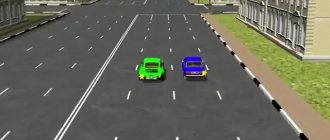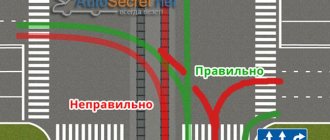Traffic violators can be not only vehicle drivers, but also ordinary pedestrians. Along with motorists, they can be held accountable in accordance with the article of the Code of Administrative Offences. Among the most common offenses committed by pedestrian road users is jaywalking . In this article, we will consider in more detail the amount of the fine for violating the crossing of the road, which falls under this definition, as well as the procedure for bringing to administrative responsibility.
Rules for pedestrians crossing the road.
The rules of the road apply equally to all participants, including pedestrians, with the only difference that the established requirements for them are much smaller. When crossing the roadway, every citizen must follow a number of rules:
- Crossing the road is allowed only in places specially designated for this. In turn, such zones include: overground and underground passages, unregulated and regulated intersections and sections of the road with appropriate zebra markings, places with special road signs.
- It is allowed to cross the roadway along the curb line, as well as the sidewalk in places without signs and markings, if there is no likelihood of causing interference to other traffic participants.
- If there are no markings, then one should cross the road perpendicularly from one edge of the sidewalk to the other.
- At controlled pedestrian crossings, you must wait for the permission signal from the inspector or traffic light;
- Despite the priority of movement along the zebra crossing, when crossing uncontrolled intersections, you should make sure that all traffic stops in a timely manner.
Important:
It is worth noting that drivers are required to give way to pedestrians crossing the crossing in a designated place. Failure to comply with these requirements is a violation of Article 12. 18 of the Code of Administrative Offenses. However, you should not risk your life and health, proving that you are right, and throw yourself under a car.
- Crossing the roadway should be done without creating or provoking emergency situations.
- Movement along the transition is carried out without stopping. The only exceptions are cases of passage of special government vehicles, as well as vehicles that do not have time to stop.
- To avoid accidents, all pedestrian actions must be unambiguous and visible without misleading other road users. In turn, this can be a sudden change in direction of movement, a sudden exit onto the roadway, etc.
- If a pedestrian moves at night outside a populated area, then his clothing should be equipped with reflective stripes or bandages.
- It is prohibited to cross the roadway in places not intended for this purpose.
It is worth noting that vehicles with special light and sound signals have priority in traffic. Therefore, both motorists and pedestrians must let them pass at intersections and crossings.
Violations when crossing the road that lead to punishment for the pedestrian
In Russia, any urban roadway has pedestrian crossing zones. These zones are located on those sections of the road where the greatest flow of pedestrians is possible. However, even with the most convenient location of pedestrian crossings, there are violators who try to take a shortcut by crossing the roadway in a prohibited place. It is important to understand that such non-compliance with traffic rules can be dangerous both for the offender himself and for other representatives of the road traffic.
According to the rules, you can cross the road only in permitted places.
In addition, there is the possibility of crossing the road in undesignated areas under the mandatory combination of the following circumstances:
- lack of places visible to pedestrians for crossing;
- lack of dividing strip and road barriers;
- if moving vehicles are either completely absent in the visibility zone or are located at a sufficient distance from the pedestrian;
- absence of objects that interfere with the view of the road;
- Movement on the roadway outside the transition zone must be perpendicular to it.
In situations that do not meet the conditions described above, the pedestrian is considered to be violating traffic rules. This is a reason to bring him to administrative and sometimes criminal liability.
What falls under the crossing in the wrong place?
Jumping is the fact of any crossing of the road in areas without special signs and markings, as well as failure to comply with the rules of one’s own safety while driving through the roadway.
Thus, an offense is committed if the road crossing occurs outside:
1. Ground crossings are regulated and unregulated areas with zebra markings on the road and/or marked with a special sign.
2. Overpass - a structure passing over the highway.
3. Underpass - a tunnel-like structure passing under the road surface.
The most common cases of illegal road crossing include:
- Selecting a site for crossing the roadway far from the designated areas;
- Crossing the road before reaching a pedestrian crossing;
- Ignoring the presence of a crossing, for example, an overpass, and following the road along the carriageway;
- Creating an emergency due to inattention, haste or disregard for the safety of movement.
- Lack of reflective emblems on pedestrian clothing at night.
It is worth noting that an accident involving a vehicle and a pedestrian outside the transition zone does not entail criminal liability for the driver if the accident resulted in serious harm, including death, to the other party. In this case, the citizen driving the car may be held financially liable under the Civil Code, but only on the basis of civil proceedings.
Can they be held accountable based on camera footage?
Will a pedestrian face a fine for jaywalking if the offense is detected by photo and video cameras? Equipment for recording offenses has been installed in almost all populated areas, but it is extremely difficult to hold pedestrians accountable:
- The camera recognition system allows you to determine the car model and state registration number, while it is almost impossible to confirm the identity of a citizen in this way;
- in most cases, recording cameras are aimed at the roadway, which will not allow an objective conclusion to be made about all the circumstances of the road crossing;
- The Code of Administrative Offenses of the Russian Federation contains reference to the use of recording cameras only for violations related to driving a car.
Although there is no fine for jaywalking according to recording cameras, photo or video recordings can be used as evidence in court proceedings. For example, if the unlawful actions of a pedestrian resulted in a collision of cars and damage, the legal collection will require recordings from external surveillance cameras or car DVRs.
A fine under the Code of Administrative Offenses for crossing the road in the wrong place.
So, administrative liability for violating a road crossing occurs under articles of the Code of Administrative Offenses No. 12.29, as well as 12.30. In turn, punishment can have the following types:
1. Warning. As a rule, it is given to pedestrians for a first violation that does not result in serious consequences.
2. Fine:
- 500 rubles for crossing the road in the wrong place repeatedly or more times;
- 1,000 rubles for an incorrect crossing that caused interference with transport, as well as an emergency situation. As a rule, for this there must be an evidence base in the form of photos, videos and eyewitness accounts;
- 1,000 - 1,500 rubles , if the actions of a pedestrian led to an accident causing harm to the health or life of at least one of the participants.
However, a similar preferential rule applies to pedestrians on a par with car owners. If the fine is paid within twenty days, then half of the amount specified in the resolution must be paid.
Where should you cross the road?
Contrary to the popular belief that citizens have the right to cross the street only at a crossing, this is not entirely true. Crossing the road in the wrong place is an administrative offense only if there are grounds to believe that the citizen’s actions created an emergency situation or there was a risk of its occurrence. In other cases, citizens are allowed to cross the roadway of city streets and country roads (with the exception of expressways with busy traffic) without the risk of being fined.
A citizen can cross the street outside the zebra crossing only if there are no cars in sight. If we are talking about intersections where there is no zebra crossing or no traffic light, then crossing the roadway is allowed only after assessing the traffic situation and only at right angles. Crossing an intersection diagonally is considered a violation.
Regarding how to check the penalty for jaywalking, the answer to this question is very simple. Unlike motorists, who can be fined based on the video recording system of violations, using the vehicle license plate number, it is impossible to fine a pedestrian without identifying him. Thus, if a citizen was given a fine, this should have happened with the participation of the inspector and the pedestrian himself. If the fine was assigned and paid, then its status can be seen on the official website of the traffic police through the online request form.
Prosecution for crossing the road in the wrong place.
Since crossing the road incorrectly is a violation of traffic rules, the procedure for liability is the same for drivers and pedestrians. The whole process consists of the following stages:
- The fact of violation of traffic rules by a pedestrian is established;
- Measures are taken to ensure administrative violation proceedings;
- Collection of evidence confirming the pedestrian’s guilt;
- An administrative protocol is drawn up.
- The case of the offense is considered, following which a decision is made.
- The decision made can be appealed by the culprit if he has made an appropriate decision.
In turn, stages 1 – 5 are carried out by the traffic police authorities within their competence.
How to challenge a traffic police fine for a pedestrian?
Compliance with traffic rules on the road by all road users is part of the general culture . However, quite often you can encounter violations committed by both drivers and pedestrians. Such behavior on the road often turns into tragedy.
You often have to watch pedestrians cross the road in the wrong places, hoping for the discretion of the motorist, and sometimes just at random.
But the driver does not always have time to react; As a result, the pedestrian ends up in a hospital bed, or even loses his life.
Under the new rules, a driver who fails to give way to a pedestrian will pay a fine. But what if it’s not his fault? Is it possible to appeal a ticket for a pedestrian?
Pedestrians and crossings: what has changed?
In 2021, penalties for both parties for violating traffic rules have been increased. Some concepts have also undergone changes.
Traditionally, a pedestrian was defined as a person walking. Now, pedestrians also include motorcyclists and cyclists who walk and roll vehicles next to them. In addition, people riding on roller skates, skis, boards, scooters and in wheelchairs are also considered pedestrians.
A pedestrian crossing is a section of road designed for people to safely cross the roadway . According to the new rules, tram tracks located in this area are also considered pedestrian crossings.
So now the tram is obliged to give way to a moving person, and not vice versa. As you know, the transition zone is indicated by road signs or markings.
All road users are required to comply with the rules prescribed by the Code of Administrative Offenses, in accordance with which everyone is responsible for their violations.
Drivers need to know when to give way to pedestrians, and people walking need to remember where to cross the street.
Almost every motorist is sure that when he sees a pedestrian on the road, he must slam on the brakes and let him pass.
But according to the new rules, the pedestrian is not allowed to pass, they are “give way”, that is, they are not prevented from completing the maneuver and are allowed to calmly cross the road without changing the direction and speed of movement.
In the old version of clause 14.1 of the traffic rules, it is noted that the driver is obliged to slow down or stop in front of a zebra crossing if a pedestrian steps onto the roadway.
The updated version of the rules allows a car to pass through a zebra crossing if the trajectories of both road users do not intersect and the number of lanes allows this. Otherwise, priority is given to the pedestrian, and the driver is obliged to slow down.
For example, if a driver is moving along the far left lane of a four-lane road, and at that time a pedestrian has just begun to cross the road, then the car can safely pass, since it does not interfere with the person’s movement.
Note to drivers! On a multi-lane road, follow the “two lanes” rule; this means that at least 2 lanes must remain between the vehicle and the pedestrian.
Even if the traffic light turns green, the driver must wait until the pedestrian calmly reaches the end of the crossing (Section 14.3 of the Traffic Regulations). At the same time, he is not obliged to let people standing on the sidewalk pass who intend to cross the road.
They are not participants in the traffic, but they can become one in a second, stepping right in front of the car.
Advice for drivers: always reduce your speed in front of a pedestrian, even if you do not notice people. The transition is a potential danger, and you cannot relax here.
Note! If previously it was impossible to overtake another car at a crossing if there was a pedestrian there, the new rules prohibit overtaking at a crossing in any case. Otherwise, a fine cannot be avoided.
Crossing areas are not always marked on the road. However, the driver must allow:
- blind people (holding a white cane);
- people walking to a bus or tram;
- children getting out of a vehicle with the emergency lights on and the “Transportation of Children” sign.
The courtyard is a pedestrian zone . Here the advantage always remains with the person on foot.
What to do on turns? Paragraph 13.1 of the traffic rules also stipulates this point in favor of the pedestrian. The motorist is obliged to let him pass, even if he crosses a red light.
A separate point is given to turns at the intersection (clause 13.7). If a driver enters an intersection when the traffic light is green, he must complete the maneuver without letting anyone pass.
But if there are stop lines, he must also take into account traffic signals for pedestrians.
: First Broadcast on NTV. Pedestrians - “Yield” and “Pass”
Often it is pedestrians who provoke emergency situations by crossing the road in the wrong place. Many of them don’t even look around, believing that they should be let through in any case. But this is an incorrect interpretation of traffic rules.
Pedestrians are also required to comply with traffic laws, namely:
- cross the street only at pedestrian crossings;
- follow the green traffic light at a controlled intersection;
- cross the street only at an angle of 90° if there are no cars nearby;
- When stepping on a zebra crossing, slow down and notify drivers of your intention to cross the street.
For pedestrians who do not comply with these rules, the following penalties are provided this year:
- violation that did not result in traffic violations – 500 rubles;
- violation resulting in interference with the car – 1000 rubles;
- violation resulting in minor damage to the health of another traffic participant - 1,500 rubles.
Note to pedestrians: If at the crossing you see a moving ambulance, police or fire truck with a siren and flashing lights, give way.
Failure to give way to a pedestrian - pay a fine
Despite stricter rules, the number of pedestrians injured at crossings is only growing.
Often both parties are at fault. However, the owner of the vehicle is always responsible.
For this offense, the driver will suffer administrative punishment in accordance with Art. 12.18 Code of Administrative Offenses of the Russian Federation. If you don’t give way at a crossing, you will pay 1,500 rubles .
By the way, from January 1, 2017, you can pay half of the fine within 20 days from the date of the decision.
Fines for hitting a pedestrian:
- For minor damage - confiscation of the certificate for 1-1.5 years or a fine of 2500-5000 rubles.
- Moderate damage - up to 20,000 rubles. or deprivation of rights for 1.5-2 years.
- If a pedestrian is seriously injured or killed, penalties up to and including imprisonment apply.
In addition, the victim has the right to demand compensation for damage to health.
At the trial of the collision, the following factors will also be taken into account:
- driver's condition;
- whether he helped the victim or fled the scene.
How should a driver who hits a pedestrian behave?
Despite your emotions, act as follows:
- Do not leave the scene of the accident.
- Do not turn off the DVR.
- Install a warning sign on your car.
- Do not touch anything at the accident scene.
- Call an ambulance and the police.
- Take a photo of your surroundings.
- Provide first aid to the victim.
If you are inclined to think that you did not commit an offense, then you can try to “get out” of the fine. Your actions when your car is stopped by a traffic police inspector:
- Ask the inspector to introduce himself, show the document and state the reason for the stop.
- require a protocol to be drawn up.
- Involve the pedestrian as a witness. If he suddenly jumped out onto the road, then tell him that according to the law he will also be punished. As a result, the pedestrian will be forced to admit that the driver did not interfere with his movement.
- Use the car registrator recording, as well as the testimony of people who were nearby at that moment.
If the inspector refuses to question the pedestrian, and the violation was not recorded by video cameras, then perhaps this is simply a money scam on his part (it’s a pity, but this also happens).
In this case, there is simply no corpus delicti. What kind of protocol, let alone punishment, can we talk about then?
If the protocol is nevertheless drawn up, it is recommended to sign it, otherwise it will be more difficult to prove your case when appealing. At the same time, on the back of the protocol, in the column “explanation of the violator,” describe your vision of the situation.
The traffic police fine can be challenged . Within 10 days, write a complaint to the head of the traffic police, or better yet, immediately to the district court. Attach evidence of your innocence (photos, videos).
If circumstances in your case play against you, then you can take advantage of other nuances, for example:
- uncertified measuring instruments of the traffic police inspector;
- lack of witnesses;
- errors in document preparation.
If the court makes a decision not in your favor, then you have the right to file a complaint with a higher authority. However, this must be done if you are absolutely sure that you are innocent. If the complaint is rejected, you will pay a double fine .
So, the updated rules, which came into force in 2021 and are in effect in the current year 2021, clearly delineate the responsibilities of all road users. In this case, priority is still given to the pedestrian, although he is also charged for violating traffic rules.
All that remains is to advise the driver to be extremely careful, always slow down before a pedestrian crossing, and in the event of an unjustified fine, to be able to defend his innocence.
You will be interested in:
Source: https://pravo-auto.com/kak-osporit-shtraf-gibdd-za-peshehoda/
Appeal against the decision.
Pedestrians have the right to appeal a decision made against them in the following order:
1. Write and send a statement on your behalf to the head of the traffic police department that adopted the resolution, demanding its cancellation;
2. If the application is refused or ignored, then a claim is filed with the court at the location of the inspection;
3. The case is considered in court, taking into account all the evidence presented.
4. A decision is made in favor of the plaintiff or defendant. If the claim is satisfied, the court sends an extract of the decision to the traffic police department. At the same time, the applicant has the right to independently transfer it to the destination address.
5. A resolution is formed that cancels the previous one.
It is worth noting that the decision can be appealed without filing an application with the traffic police.









